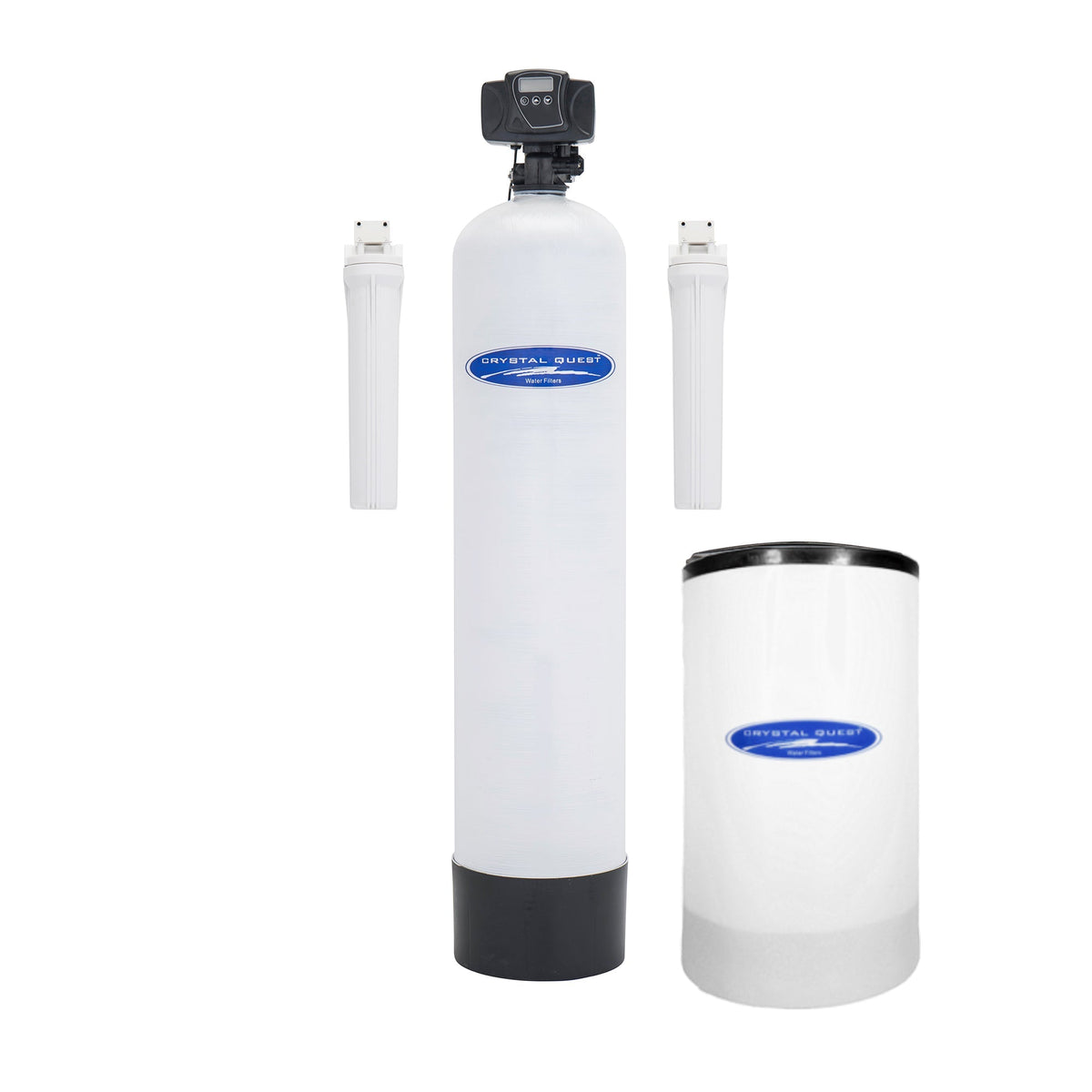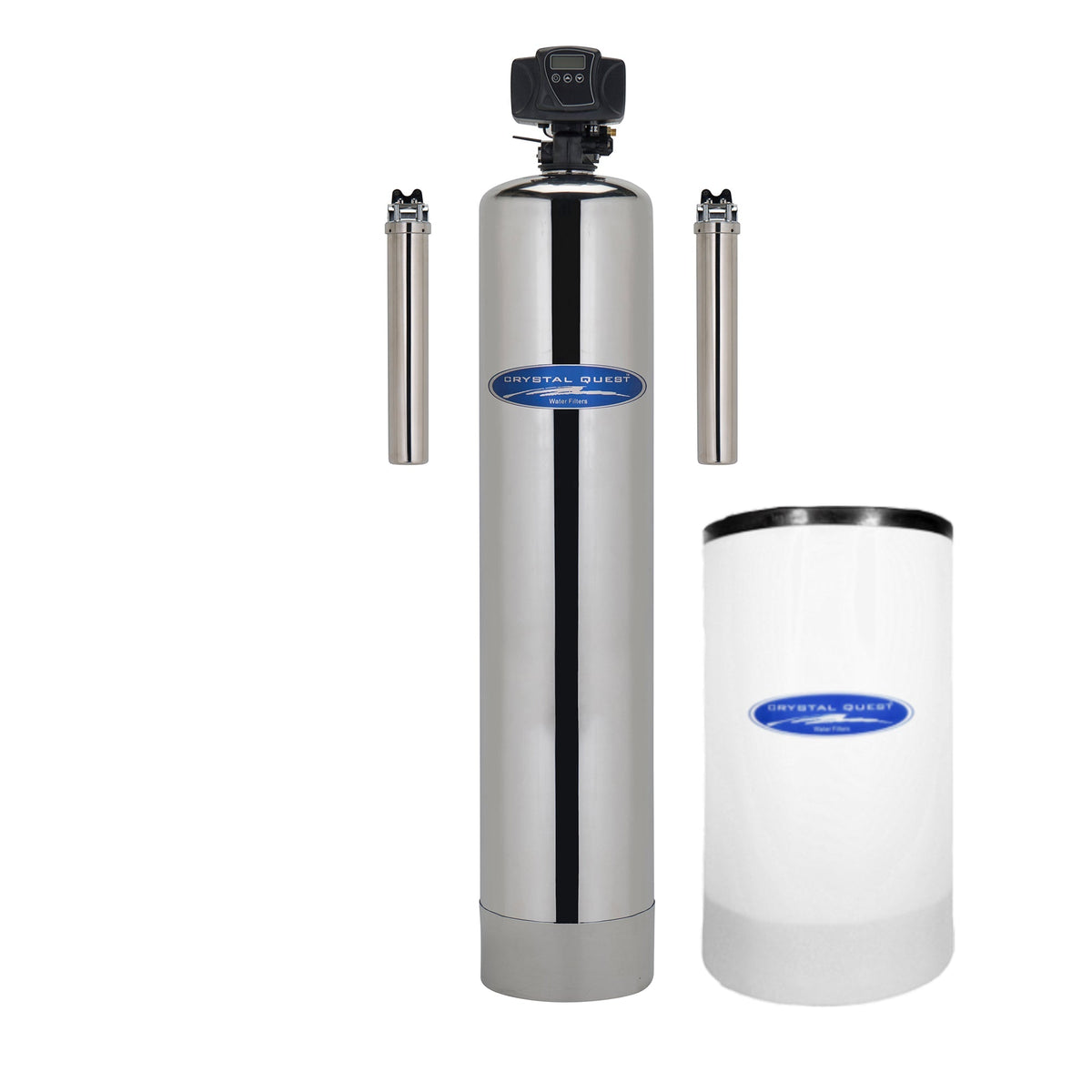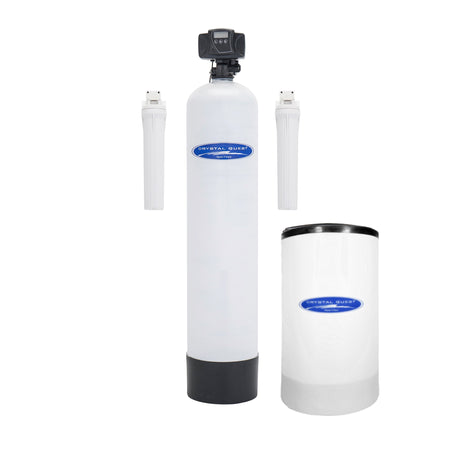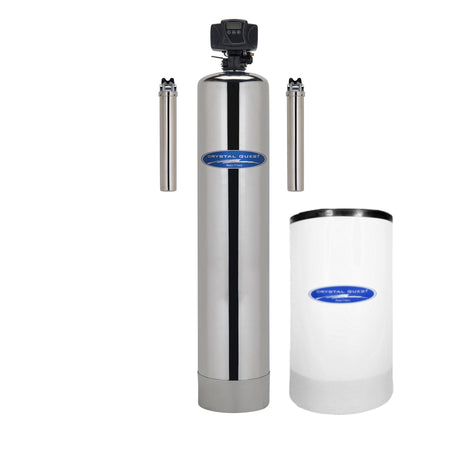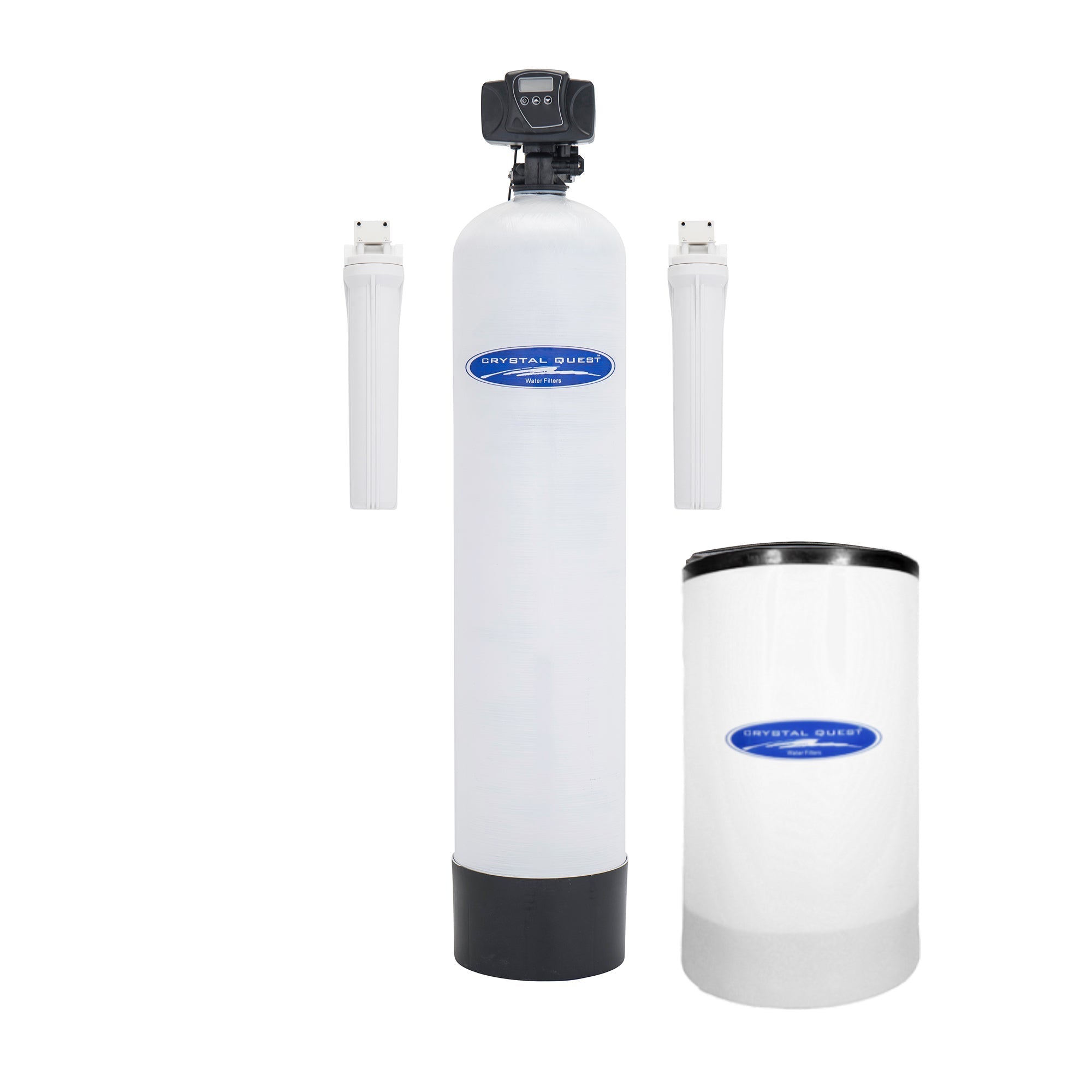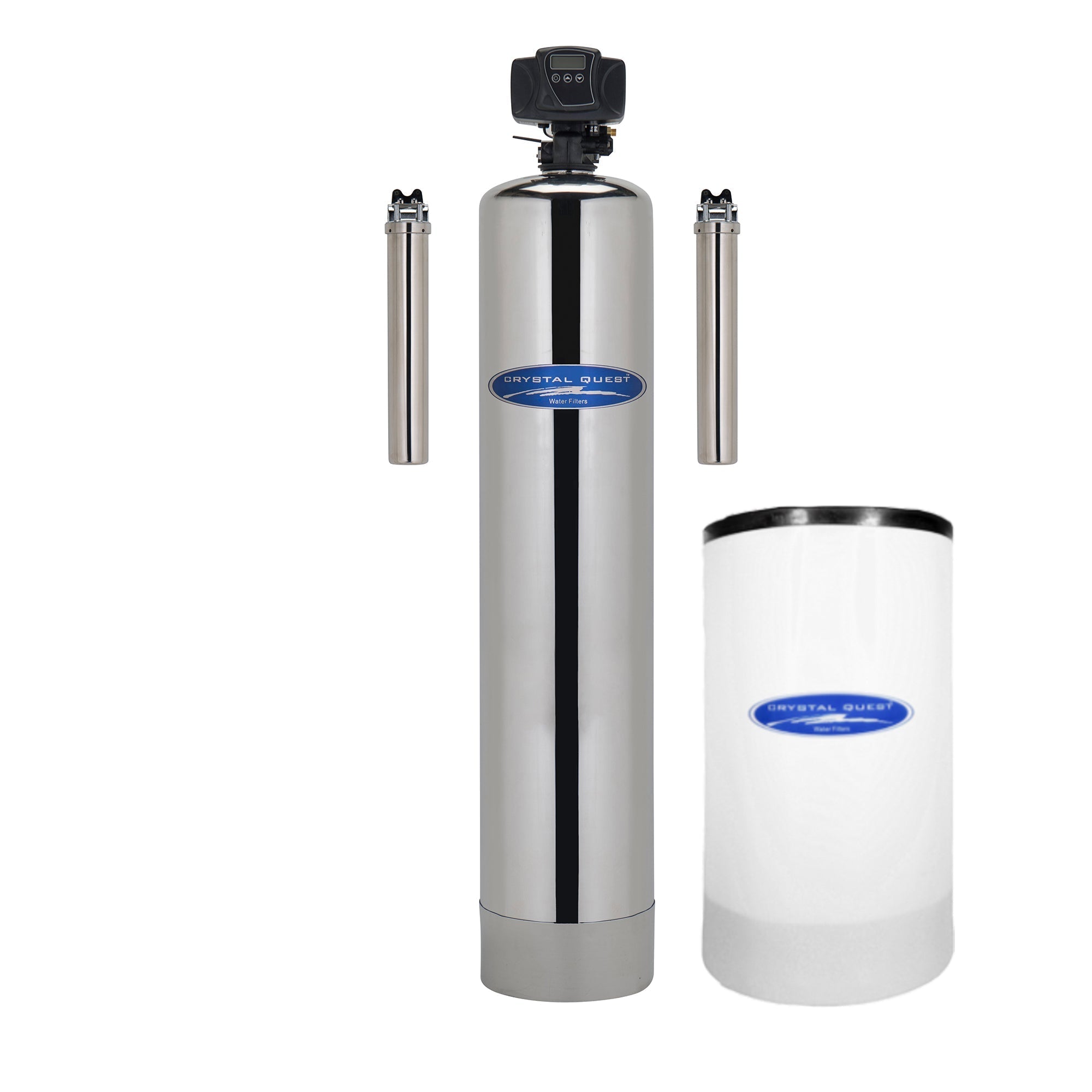Whole House Water Softener with Pre/Post Filtration
Couldn't load pickup availability
Description
Water is hard when it contains minerals like calcium and magnesium. You may see staining on your sinks, tubs, showers, and clothing. You may also notice less lather from your shampoos and soaps and even a feeling of film on your skin. All these are symptoms of the need for softened water.
Hard water also causes a higher risk of limescale deposits in household water systems. The negative effect of limescale buildup is that pipes are blocked and the efficiency of hot boilers and tanks is reduced. This increases the cost of domestic water heating by about fifteen to twenty percent. Another negative effect of limescale is that it has damaging effects on household machinery, such as laundry machines. Water softening means expanding the lifespan of household machines, and the lifespan of pipelines. It also contributes to the improved working and longer lifespan of solar heating systems, air conditioning units and many other water-based applications.
Water is softened or conditioned by replacing hard ions like calcium and magnesium with softer sodium or potassium ions. Water softeners must be regenerated** regularly, renewing their ability to remove hardness from water. Time-initiated or solid state softeners regenerate at a fixed time when their softening capacity is predicted to be low. Demand-initiated softeners regenerate automatically when they sense their capacity is low.
Water Travels Through 3 Stages of Filtration
- Stage 1 - Water flows through a 20” sediment cartridge that removes sediment, silt, sand, and dirt.
- Stage 2 - Water flows through an ion exchange mineral tank and brine water conditioner.
- Stage 3 - Water flows through a 20” solid carbon cartridge for removing volatile organic carbon compounds (VOCs), insecticides, pesticides and industrial solvents.*
*If present in the water
**Frequent regeneration with sodium chloride (salt) or potassium chloride required.
Important to Know
Pinholes or rust may occur on stainless steel tanks in environments with high humidity, when salt is present or if condensation remains on tank without being routinely wiped down. If your system will be exposed to one of these factors or you are unable to perform the needed maintenance, we recommend a fiberglass tank.
Water Softener Replacement Media
EAGLE Multimedia Replacement Media
OUR GUARANTEED PERFORMANCE
|
STANDARD |
 |
 |
* All parts, components, and media are Certified
Specifications
- 1.5 cu. ft. resin
- 48,000-grain capacity
- Service Flow: 9-11 GPM
-OR-d
- 2.0 cu. ft. resin
- 60,000-grain capacity
- Service Flow: 10-13 GPM
Replacement Media
| Product Name | SKU |
|---|---|
| Eagle Multimedia | CQE-RM-05001 |
| Eagle Water Softener Resin | CQE-RM-05002 |
Replacement Cartridges
| Product Name | SKU |
|---|---|
| Pleaded Cellulose Sediment Cartridge (2-7/8"x20") | CQE-RC-04015 |
| Carbon Block Filter Cartridge (2-7/8"x20") | CQE-RC-04014 |
Product Manual
Description
Water is hard when it contains minerals like calcium and magnesium. You may see staining on your sinks, tubs, showers, and clothing. You may also notice less lather from your shampoos and soaps and even a feeling of film on your skin. All these are symptoms of the need for softened water.
Hard water also causes a higher risk of limescale deposits in household water systems. The negative effect of limescale buildup is that pipes are blocked and the efficiency of hot boilers and tanks is reduced. This increases the cost of domestic water heating by about fifteen to twenty percent. Another negative effect of limescale is that it has damaging effects on household machinery, such as laundry machines. Water softening means expanding the lifespan of household machines, and the lifespan of pipelines. It also contributes to the improved working and longer lifespan of solar heating systems, air conditioning units and many other water-based applications.
Water is softened or conditioned by replacing hard ions like calcium and magnesium with softer sodium or potassium ions. Water softeners must be regenerated** regularly, renewing their ability to remove hardness from water. Time-initiated or solid state softeners regenerate at a fixed time when their softening capacity is predicted to be low. Demand-initiated softeners regenerate automatically when they sense their capacity is low.
Water Travels Through 3 Stages of Filtration
- Stage 1 - Water flows through a 20” sediment cartridge that removes sediment, silt, sand, and dirt.
- Stage 2 - Water flows through an ion exchange mineral tank and brine water conditioner.
- Stage 3 - Water flows through a 20” solid carbon cartridge for removing volatile organic carbon compounds (VOCs), insecticides, pesticides and industrial solvents.*
*If present in the water
**Frequent regeneration with sodium chloride (salt) or potassium chloride required.
Important to Know
Pinholes or rust may occur on stainless steel tanks in environments with high humidity, when salt is present or if condensation remains on tank without being routinely wiped down. If your system will be exposed to one of these factors or you are unable to perform the needed maintenance, we recommend a fiberglass tank.
Water Softener Replacement Media
EAGLE Multimedia Replacement Media
OUR GUARANTEED PERFORMANCE
|
STANDARD |
 |
 |
* All parts, components, and media are Certified
Specifications
- 1.5 cu. ft. resin
- 48,000-grain capacity
- Service Flow: 9-11 GPM
-OR-d
- 2.0 cu. ft. resin
- 60,000-grain capacity
- Service Flow: 10-13 GPM
Replacement Media
| Product Name | SKU |
|---|---|
| Eagle Multimedia | CQE-RM-05001 |
| Eagle Water Softener Resin | CQE-RM-05002 |
Replacement Cartridges
| Product Name | SKU |
|---|---|
| Pleaded Cellulose Sediment Cartridge (2-7/8"x20") | CQE-RC-04015 |
| Carbon Block Filter Cartridge (2-7/8"x20") | CQE-RC-04014 |

